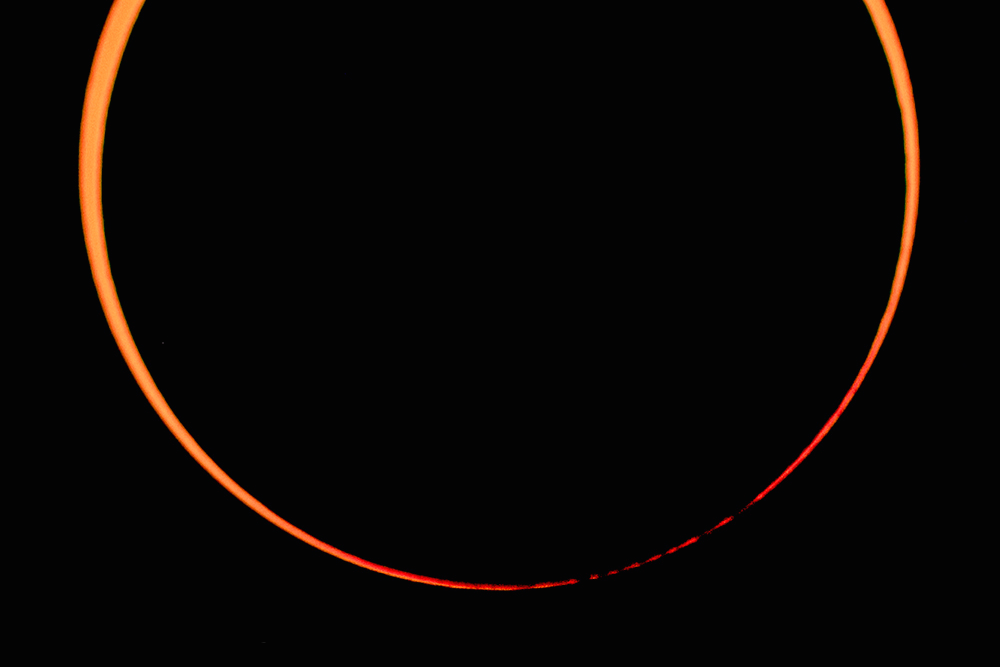
Drama, in the form of sublime celestial geometry, is once again coming to our planet. On June 10, 2021, the Sun, the Moon, and Earth will form a straight line in space. While this scenario often produces a total eclipse, this time, the Moon will be too far from us to completely cover the solar disk. The result? People along a narrow path that stretches through Canada, Greenland, and Russia will experience an annular eclipse.
This event derives its name from the Latin annulus, meaning “ring.” That’s because, at mid-eclipse, a ring of the Sun’s disk is still visible around the Moon. And that means one important thing for anyone watching: You must use approved solar glasses or solar filters for binoculars or telescopes when observing.
During an annular eclipse, the dark inner shadow of the Moon (the umbra) never reaches Earth. Astronomers, however, call the virtual extension of that shadow the antumbra. If you’re beneath the antumbra, you will see annularity. The Moon also has a lighter, outer shadow called the penumbra. Anyone under the penumbra will witness a partial eclipse.
The nitty-gritty
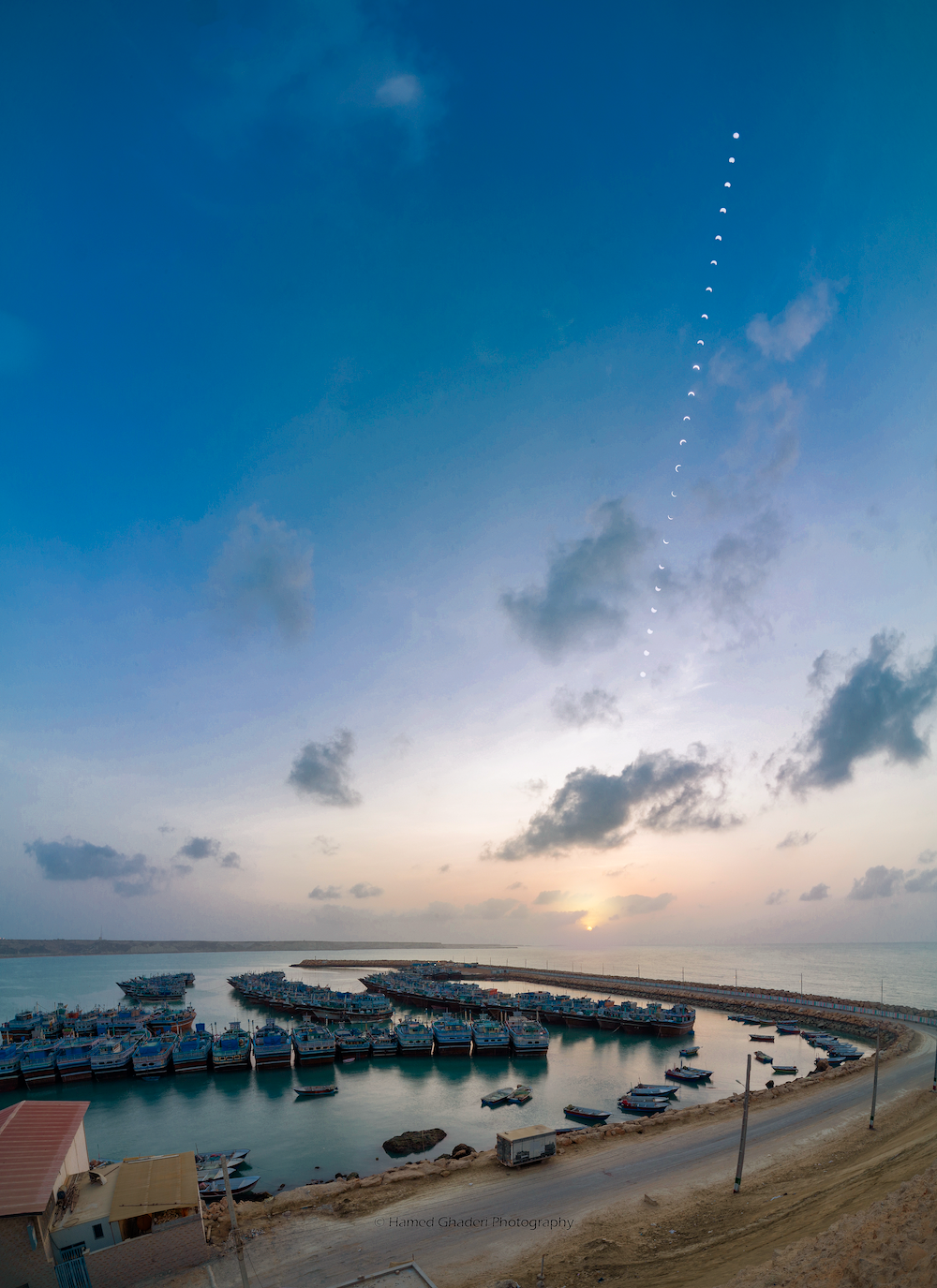
The Moon’s penumbra first touches Earth at 4:12:16 a.m. EDT. The shadow remains in contact with our planet for nearly five hours, finally leaving at 9:11:16 a.m. EDT. The antumbra first touches Earth’s surface at 5:49:43 a.m. EDT and its final contact with our planet is at 7:33:45 a.m. EDT. This stretch marks the annular part of the eclipse. The total path length is 4,831 miles (7,775 kilometers). Greatest eclipse occurs at 6:41:51 a.m. EDT at longitude 66°48′ West and latitude 80°49′ North, 150 miles (241 km) south of Alert, Nunavut, Canada, the northernmost permanently inhabited place on Earth.
The magnitude of this eclipse is 0.9152. This means the Moon’s apparent diameter, 29’33.6″, will be 91.5 percent that of the Sun’s, which will be 31’30.4″. At the midpoint of the eclipse, annularity lasts 3 minutes 51 seconds.
This stunning, fiery ring occurs in the constellation Taurus the Bull, at right ascension 5h15m31s and declination 23°02’37”. But it won’t be the only sight in the sky: During the eclipse, Venus will lie 20° east of the Sun, shining at magnitude –3.9. The nearby world may be visible a few minutes before maximum annularity, but spotting it will be a difficult task, as it will be low on the horizon. The Sun’s maximum altitude during the eclipse will be 23°. If you search for Venus through binoculars, be sure not to sweep the Sun into your field of view.
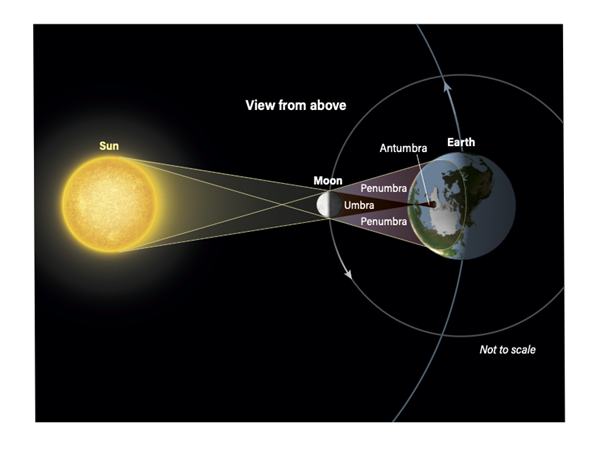
Canada and Greenland
This eclipse begins some 130 miles (210 km) north of Thunder Bay, Ontario (see the map on page 49). Eclipse chasers selecting that region as their observing site might head to Polar Bear Provincial Park, which lies on Hudson Bay. From there, you’ll enjoy an unobstructed view (over water) to the north-northeast with the Sun 6° above the horizon. The duration of annularity along the center line will be 3 minutes 33 seconds.
Another vantage point is the northern coast of Akimiski Island in James Bay, Canada. While there, you could visit the Migratory Bird Sanctuary, which occupies the eastern two-thirds of the island. Tourists would sacrifice 10 to 12 seconds of annularity compared to Polar Bear Provincial Park, but they also might spot ringed seals, polar bears, and beluga whales. As the center line crosses the Belcher Islands, the duration of annularity increases a few seconds and the Sun’s mid-eclipse altitude climbs to 9°.
The antumbra next touches the mainland 30 miles (50 km) east of the village of Inukjuak, with 1,800 inhabitants, located at the mouth of Hudson Bay. It continues northward and reaches the Hudson Strait near the northernmost point of Quebec. At water’s edge, the Sun stands 15° high at mid-eclipse and annularity lasts 3 minutes 38 seconds. The shadow then crosses more than 800 miles (1,300 km) of Nunavut province. At the coastline of Baffin Bay, annularity begins around 6:19 a.m. EDT. It lasts 3 minutes 43 seconds, with the Sun nearly 21° high in the east and a perfect watery horizon below it. Unfortunately, weather prospects here are not good. In Canada’s boreal forest in June, cloud cover generally ranges from 50 to 60 percent at the beginning of the eclipse track to about 85 percent farther north.
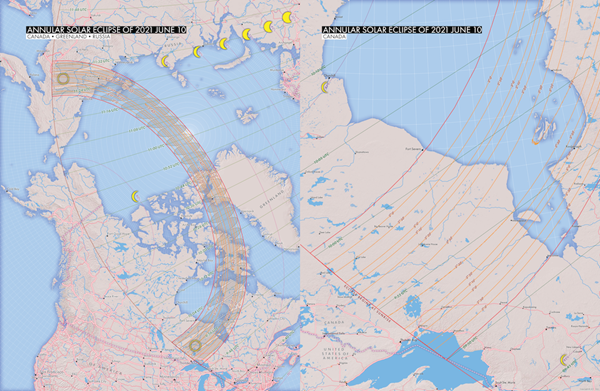
The center line next touches land 20 miles (32 km) west of Savissivik, Greenland. This tiny community of fewer than 100 people is located on the southwestern end of Meteorite Island — a destination that could prove interesting to astronomy buffs. This is where the famous Cape York meteorite fell to Earth more than 10,000 years ago. Its main fragment is the third-largest iron meteorite, weighing nearly 31 tons. This piece, named the Ahnighito fragment, has been on display in the American Museum of Natural History in New York City since 1904.
The Moon’s antumbra then treks across the entire northwestern side of Greenland, but it only encounters a half-dozen small villages. The closest to the center line is Qeqertat, which, at around 6:33 a.m. EDT, will experience 3 minutes 43 seconds of annularity with the Sun 23° high in the east. This region boasts the best weather prospects. The cold air there contains much less moisture than elsewhere along the path. One other destination could be Qaanaaq, where annularity lasts 3 minutes 33 seconds and where the mean cloud cover in June is just 39 percent. This is a popular tourist destination for cruise ships and Air Greenland flies into Qaanaaq Airport.
The duration of annularity for this eclipse reaches its maximum in Nares Strait, midway between Greenland and Ellesmere Island, Canada. The antumbra then reenters Canada, where the center line will track for another 220 miles (350 km). For hardy eclipse watchers who want to observe annularity from Canada’s northernmost point, head to Cape Columbia for a duration of 3 minutes 42 seconds. From that location, the Sun will stand 23° above the eastern horizon at mid-eclipse. Then, after continuing some 220 miles (350 km) north through the Arctic Ocean, the antumbra leaves Earth’s surface — but only for a few minutes.
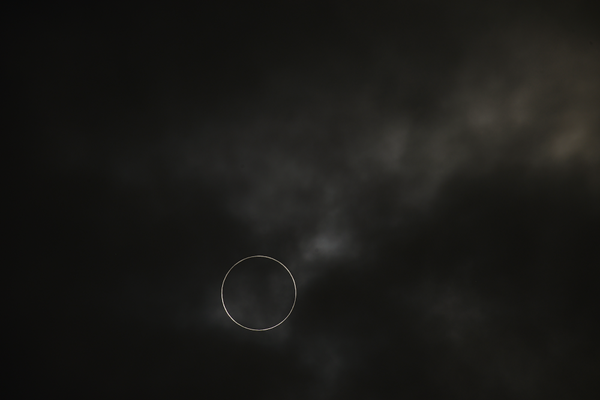
Russia
Because of the geometry of this eclipse — mainly the extremely curved path of the antumbra — after briefly leaving Earth, the shadow will once again touch our planet 1,370 miles (2,200 km) north of the New Siberian Islands in the Laptev Sea. From the northern point of Novaya Sibir, annularity lasts 3 minutes 36 seconds, but the Sun’s altitude has dropped to 12° at this location.
The center line encounters the mainland of Russia 93 miles (150 km) north of Russkoye Ustye, a village of fewer than 200 people. They will experience 3 minutes 34 seconds of annularity with the Sun 8° high in the northwest. Then, after tracking another 870 miles (1,400 km), the eclipse finally ends its contact with Earth at a point some 155 miles (250 km) north of the Sea of Okhotsk.
Unfortunately, weather prospects throughout Russia are poor, especially when you consider the Sun’s low altitude in the sky. Average cloud cover in June ranges from 65 percent to nearly 90 percent. The most favorable locations lie near the end of the eclipse path.
Wherever you choose to travel to observe June’s annular eclipse, the best strategy is to arrive a few days early, continually check the local weather report, and stay mobile. If the clouds part, you’ll certainly be one of the few people on Earth to glimpse this stunning ring of fire in person. Good luck!









